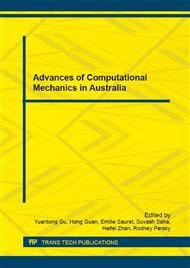p.7
p.12
p.18
p.23
p.30
p.36
p.42
p.48
p.54
A Multigrid Accelerated Code for Simulating Unsteady Conjugate Natural Convection Boundary Layers
Abstract:
This paper presents a numerical study on the flow dynamics and heat transfer behaviour of unsteady conjugate natural convection boundary layers (CNCBLs) in a partitioned, air filled square cavity. An unsteady two-dimensional multigrid-assisted solver is developed in the C#.NET programming language on stretched Cartesian meshes. The finite volume method is used to discretise the governing equations. To solve the coupled pressure and velocity, the SIMPLE algorithm is used, and to increase simulation accuracy the Adam-Bashforth, QUICK and central difference schemes are employed for time, convection, and diffusion terms respectively. The Poisson pressure equation is solved through the use of the multigrid method. The developed code is used to model CNCBLs which typically require a large amount of simulation time. The numerical results provide detailed descriptions of unsteady CNCBLs and associated heat transfer behaviour over a wide range of Ra, such as the thermal and viscous boundary layer thicknesses, temperature and velocity distributions, and maximum velocities within the CNCBLs.
Info:
Periodical:
Pages:
30-35
Citation:
Online since:
July 2016
Keywords:
Price:
Сopyright:
© 2016 Trans Tech Publications Ltd. All Rights Reserved
Share:
Citation:


